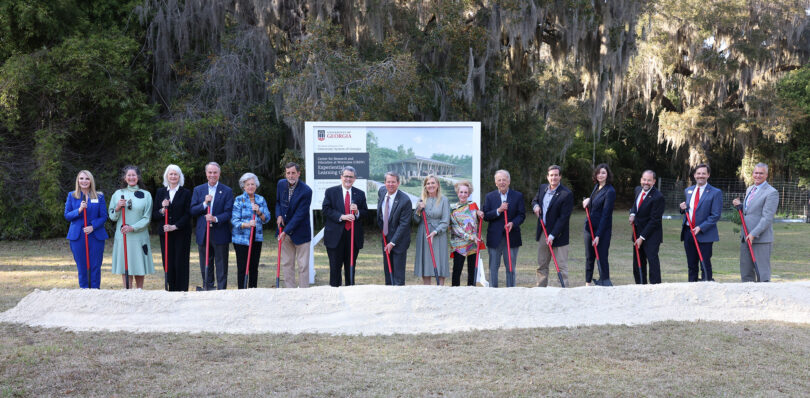A new University of Georgia facility will enhance research, education and public outreach at one of the most ecologically and historically significant sites along Georgia’s coast.
The university broke ground Thursday, March 3, on the $1.8 million Experiential Learning Center to expand educational opportunities at the Center for Research and Education at Wormsloe. CREW, a unit of the UGA Libraries, supports the work of graduate students and faculty investigating a host of environmental and sociological questions in a broad range of disciplines including ecology, archaeology, geology, landscape architecture, historic preservation, environmental planning and more.
The 3,200-square-foot multipurpose space is largely funded by private donors and the Wormsloe Foundation in honor of the conservation legacy of UGA alumna Laura Barrow McIntosh. McIntosh, who died in 2019, devoted much of her life to protecting the natural environment of the southeastern coast through advocacy and public service. The new building will expand opportunities to integrate research with educational and outreach activities for visiting scholars, students and the Savannah community.
“CREW and the Experiential Learning Center represent the University of Georgia’s commitment to interdisciplinary studies, which are needed to address the complex issues facing our world, and our commitment to learning experiences that help our students succeed after graduation,” said UGA President Jere W. Morehead. “We are deeply grateful to the Wormsloe Foundation and all of the generous donors who contributed to this new facility.”
Located on the Isle of Hope, CREW was established in 2012 on a 15.5-acre section of the historic Wormsloe estate, an expansive property claimed in the 1730s by Noble Jones, one of Georgia’s earliest settlers. In the 1950s, Noble Jones descendant Elfrida De Renne Barrow and her family established the Wormsloe Foundation to foster preservation and support research.
“The academic research that takes place here is yet another great asset for our state, which adds to Georgia’s reputation as the best place to live, work, and raise a family,” Gov. Brian Kemp said at the groundbreaking. “Building the Experiential Learning Center that will soon stand on this historic ground will only add to that reputation and further enrich the growing minds that come here to learn and experience all that this storied place has to offer.”
The UGA Libraries’ partnership with the Jones family descendants began in 1938 with the acquisition of the Wymberly Jones De Renne Georgia Library, a collection of more than 10,000 materials dating back to the Colonial period that were formerly housed at the Wormsloe estate. The materials, now preserved at the Special Collections Libraries in Athens, include the only known copy of the second Georgia Constitution of 1789 and rare books by preeminent 18th century naturalists John Abott and Mark Catesby that comprise some of the earliest depictions of North American plant and animal life, as well as a rich collection of historic maps, featuring one of the most well-known images of the early colony of Georgia drawn in 1734. In addition, the Wormsloe Foundation has partnered with the UGA Press since 1954 to publish more than 100 books on the history, culture and natural environment of Georgia and the South.
“The Center for Research and Education at Wormsloe provides a remarkable opportunity for the university to recruit talented graduate students, to research real-world challenges and to provide unique, hands-on learning experiences,” said Toby Graham, university librarian and associate provost. “We are immensely appreciative of the Wormsloe Foundation for its support and for its dedication to the preservation of this land and its history.”








